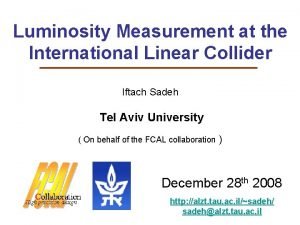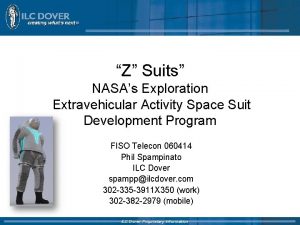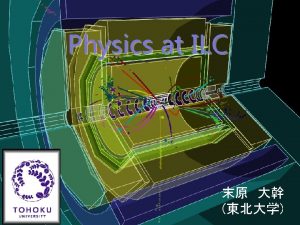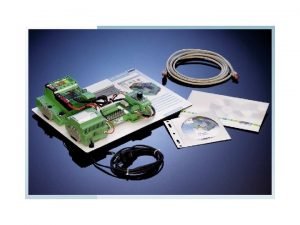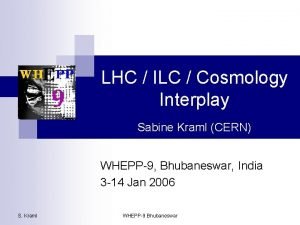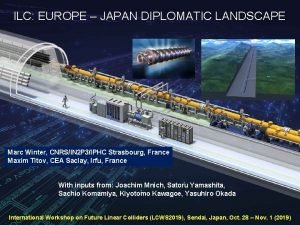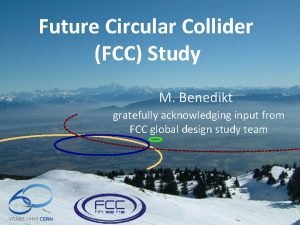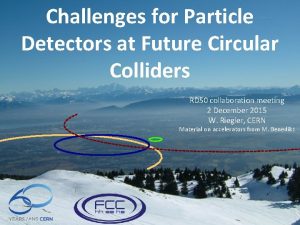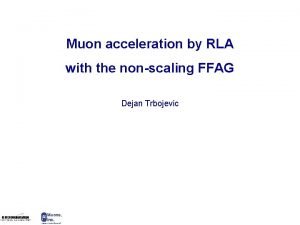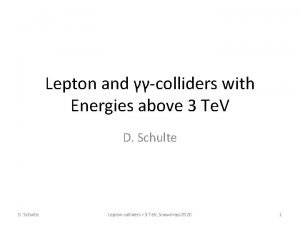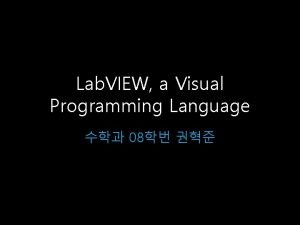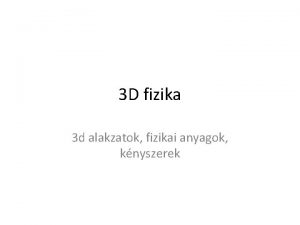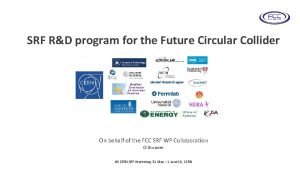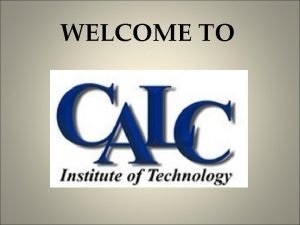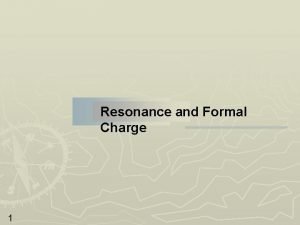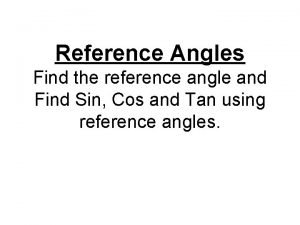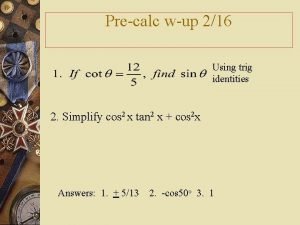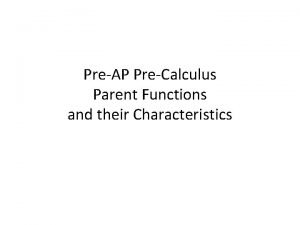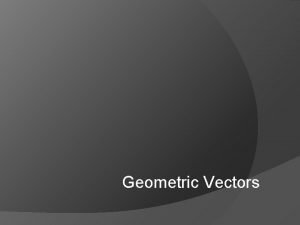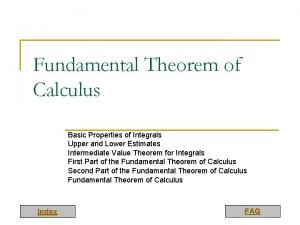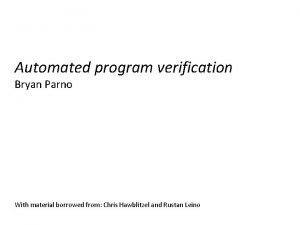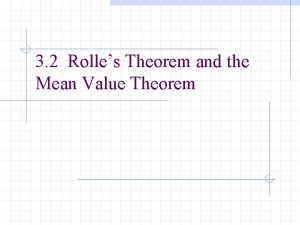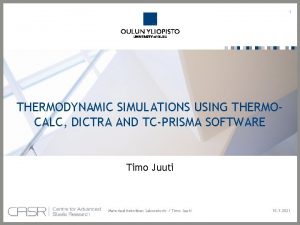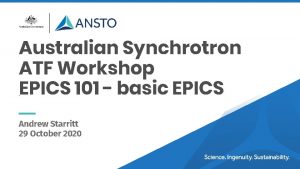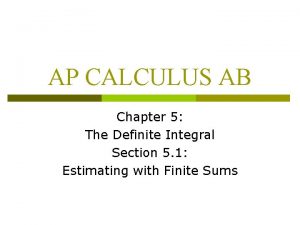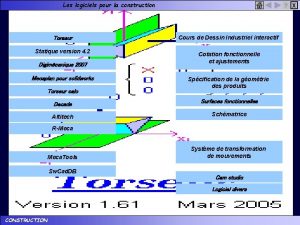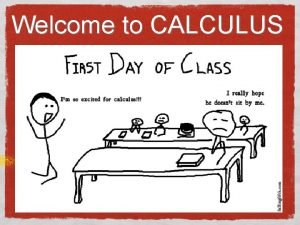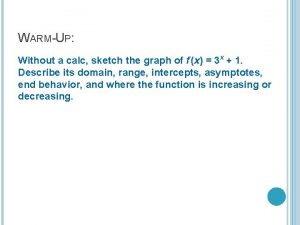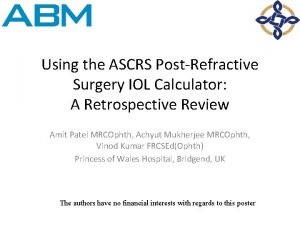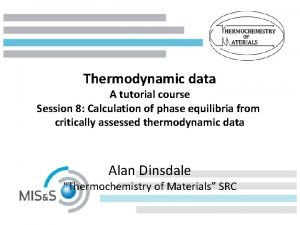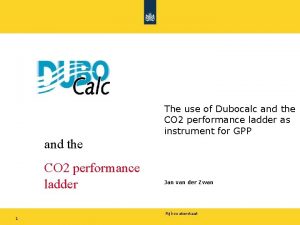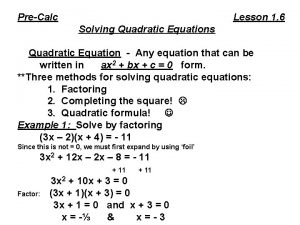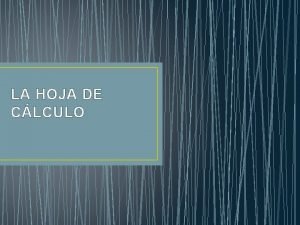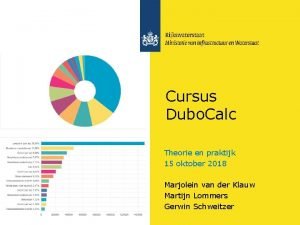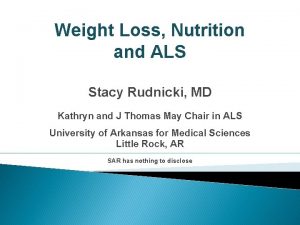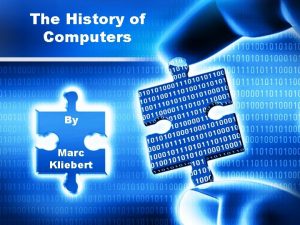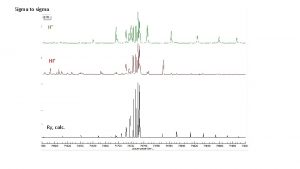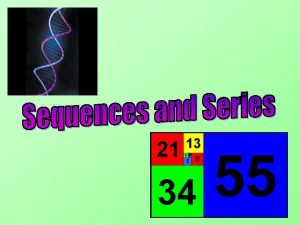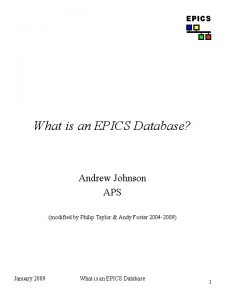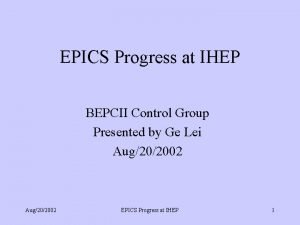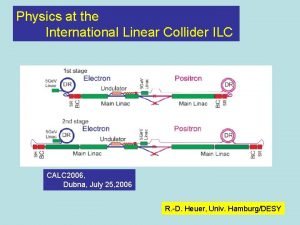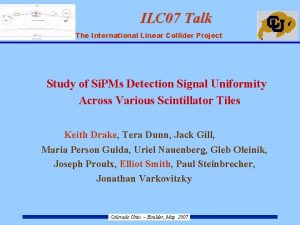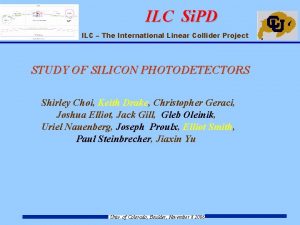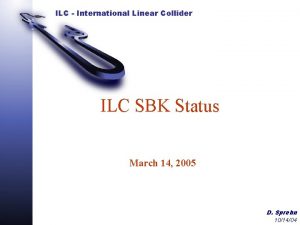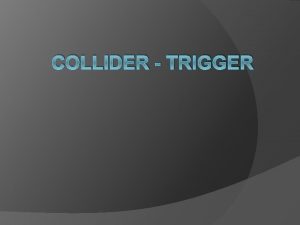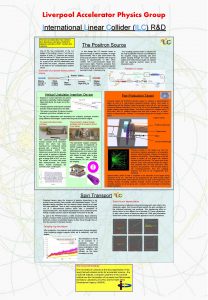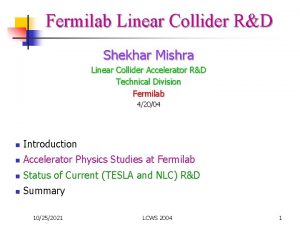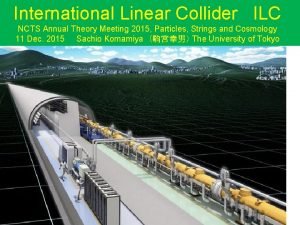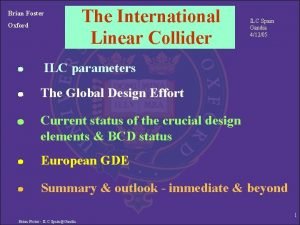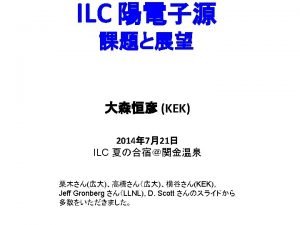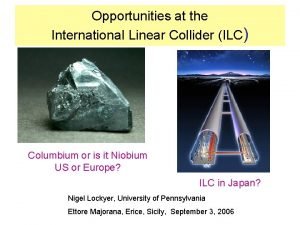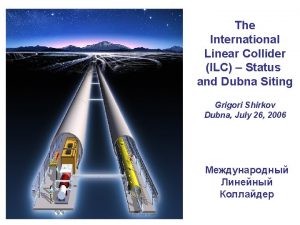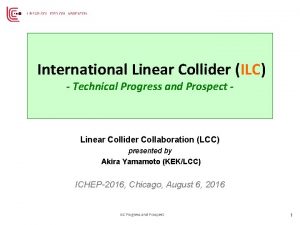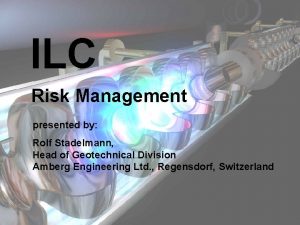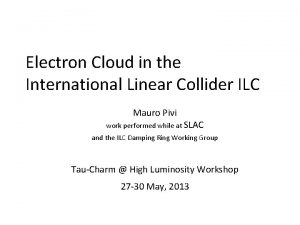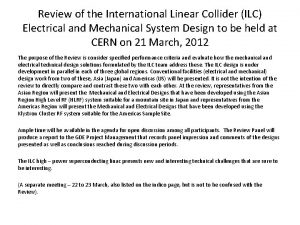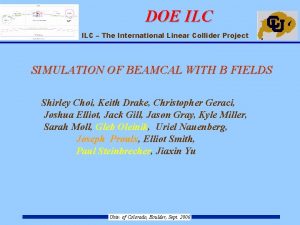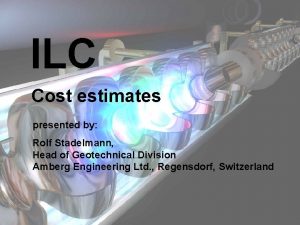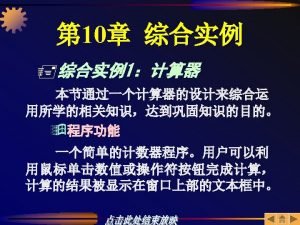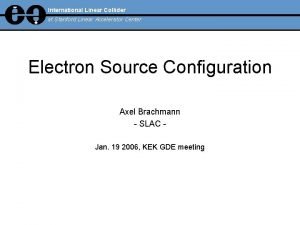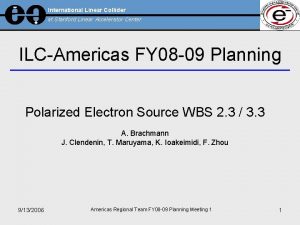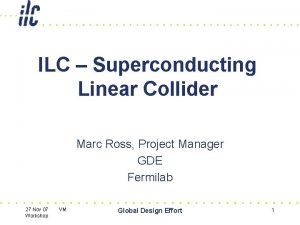Physics at the International Linear Collider ILC CALC


































































- Slides: 66

Physics at the International Linear Collider ILC CALC 2006, Dubna, July 25, 2006 R. -D. Heuer, Univ. Hamburg/DESY

Physics at the International Linear Collider ILC Introduction Physics examples Detector challenges CALC 2006, Dubna, July 25, 2006 R. -D. Heuer, Univ. Hamburg/DESY

Particle Physics Today or Status of the Standard Model 3

What have we learned the last 50 years or Status of the Standard Model The physical world is composed of Quarks and Leptons interacting via force carriers (Gauge Bosons) Last entries: top-quark 1995 tau-neutrino 2000

Tests of the Standard Model Precision measurements 1990 -2005 (LEP, SLD, Tevatron, Nu. Te. V, …) Standard Model tested to permille level Precise and quantitative description of subatomic physics Status spring 2005

Standard Model: Testing Quantum Fluctuations LEP: Indirect determination of the top mass possible due to • precision measurements • known higher order electroweak corrections

Standard Model: Testing Quantum Fluctuations Time evolution of experimental limits on the Higgs boson mass LEP, SLD, Tevatron… top indirect knowledge obtained only through combination of results from different accelerator types in particular: Lepton and Hadron Collider MH between 114 and ~200 Ge. V nonetheless……

Key Questions of Particle Physics …… many key questions in particle physics unanswered, e. g. origin of mass/matter or origin of electroweak symmetry breaking unification of forces fundamental symmetry of forces and matter unification of quantum physics and general relativity number of space/time dimensions dark matter / dark energy

The next steps at the Energy Frontier How to get the experimental answers? There are two distinct and complementary strategies for gaining new understanding of matter, space and time at future particle accelerators HIGH ENERGY direct discovery of new phenomena i. e. accelerators operating at the energy scale of the new particle HIGH PRECISION Access to new physics at high energies through the precision measurement of phenomena at lower scales © Physics Today

Hadron Collider p p Lepton Collider e+ e- p = composite particle: unknown s of IS partons, no polarization of IS partons, parasitic collisions e = pointlike particle: known and tunable s of IS particles, polarization of IS particles possible, kinematic contraints can be used p = strongly interacting: huge SM backgrounds, highly selective trigger needed, radiation hard detectors needed e = electroweakly interacting low SM backgrounds, no trigger needed, detector design driven by precision 10

The next steps We know enough now to predict with great certainty that fundamental new understanding of how forces are related, and the way that mass is given to all particles, will be found with a Linear Collider operating at an energy of at least 500 Ge. V, extendable to around 1000 Ge. V. Experimental limits on the Higgs boson mass LEP, SLD Tevatron indirect MH between 114 and ~250 Ge. V

The power of an Electron-Positron Linear Collider ● well defined initial state √s well defined and tuneable quantum numbers known polarisation of e+ and e- possible ● clean environment collision of pointlike particles low backgrounds options: e-e-, eγ, γγ ● precise knowledge of cross sections ILC = Machine for Discoveries and Precision Measurements

The Role of the ILC Explore new Physics through high precision at high energy microscopic Study the properties of new particles (cross sections, BR’s, quantum numbers) telescopic Study known SM processes to look for tiny deviations through virtual effects (needs ultimate precision of measurements and theoretical predictions) precision measurements will allow -- distinction of different physics scenarios -- extrapolation to higher energies

The ILC Physics Case or Relation of Hadron Collider and Linear Collider 1. Since the ILC will start after the start of LHC, it must add significant amount of information. This is the case! (see e. g. TESLA TDR, Snowmass report, ACFA study etc. ) 2. Neither ILC nor HC’s can draw the whole picture alone. An ILC will • add new discoveries and • precision of ILC will be essential for a better understanding of the underlying physics (see e. g. LHC/ILC report Phys. Rept. 426(2006)47) 3. There are probably pieces which can only be explored by the LHC due to the higher mass reach. Joint interpretation of the results will improve the overall picture 4. Overlapping running of both machines will further increase the potential of both machines and might be mandatory, depending on the physics scenario realized

International Linear Collider Parameters global consensus (Sept. 2003) (1) baseline machine 200 Ge. V < √s < 500 Ge. V integrated luminosity ~ 500 fb-1 in 4 years electron polarisation ~ 80% (2) energy upgrade to √s ~ 1 Te. V integrated luminosity ~ 1 ab-1 in 3 years (3) options positron polarisation of ~ 50% high luminosity running at MZ and W-pair threshold e-e-, eγ, γγ collisions (4) concurrent running with LHC desired ! Times quoted for data taking cover only part of program !

Baseline Design (2006) of the ILC ~ 500 Ge. V ~ 1 Te. V

Physics at the ILC Comprehensive and high precision coverage of energy range from MZ to ~ 1 Te. V Selected Physics Topics • Higgs Mechanism • Supersymmetry • Strong Electroweak Symmetry Breaking • Precision Measurements at lower energies cross sections few fb to few pb e. g. O(10, 000) HZ/yr

Physics Examples Electroweak Symmetry Breaking - Higgs mechanism - no Higgs scenarios Supersymmetry - unification of forces - dark matter Precision tests of the Standard Model - top quark properties - high luminosity running at the Z-pole

The Higgs: Key to Understanding Mass Dominant production processes at ILC: Task at the ILC: - determine properties of the Higgs-boson - establish Higgs mechanism responsible for the origin of mass . . . together with LHC

Tasks at the ILC Establishing the Higgs mechanism as being responsible for EW symmetry breaking requires more than discovering one or more Higgs bosons and measuring its/their mass(es). Precision measurements must comprise: Mass Total width Quantum numbers JCP (Spin, CP even? ) Higgs-fermion couplings ( mass? ) Higgs-gauge-boson couplings (W/Z masses) Higgs self-coupling (spontaneous symmetry breaking) Precision should be sufficient to distinguish between different models (e. g. SM/MSSM, effects from XD, . . . ) 20

The Higgs: Key to Understanding Mass Recoil mass spectrum ee -> HZ with Z -> l+l- s ~ 3% model independent measurement m ~ 50 Me. V sub-permille precision

ee -> HZ Z -> l l H -> qq

Precision physics of Higgs bosons m. H = ee -> HZ diff. decay channels 120 Ge. V m. H = 40 Me. V 150 Ge. V m. H = 70 Me. V

The Higgs: Key to Understanding Mass Higgs branching ratios ΔBR/BR bb cc gg tt gg WW 2. 4% 8. 3% 5. 5% 6. 0% 23. 0% 5. 4% For 500 fb-1 MH = 120 Ge. V Model-independent measurements at %-level possible

Example: Top Yukawa Coupling LHC sensitive to top Yukawa coupling of light Higgs through tth production. ILC BR measurement (h bb and h WW) turns rate measurement into an absolute coupling measurement ILC direct measurement only at high energy (> 800 Ge. V)

The Higgs: Key to Understanding Mass Higgs self coupling g. HHH Φ(H)=λv 2 H 2 + λv. H 3 + 1/4λH 4 SM: g. HHH = 6λv, fixed by MH Δλ/λ ~ 10 -20 % for 1 ab-1 requires excellent calorimeter resolution

The Higgs: Key to Understanding Mass Testing the Yukawa couplings… Precision ~ % level …through the measurement of absolute BRs:

e. g. Coupling Precision and New Physics Yamashita

Precision physics of Higgs bosons Conclusion precision measurements at the ILC together with the results from LHC are crucial to establish the Higgs mechanism responsible for the origin of mass and for revealing the character of the Higgs boson if the electroweak symmetry is broken in a more complicated way then foreseen in the Standard Model the LC measurements strongly constrain the alternative model

Beyond the Higgs Why are electroweak scale (102 Ge. V) and the Planck scale (1019 Ge. V) so disparate ? Are there new particles ? → supersymmetry new forces ? → strong interactions hidden dimensions ?

Supersymmetry Introduction of an additional symmetry to the SM: boson fermion symmetry Each SM particle gets a SUSY partner whose spin differs by 1/2. All other quantum numbers are equal. But so far no SUSY particle seen (SUSY symmetry broken) but SUSY well motivated theory 31

Solution to hierarchy problem Motivation 1: It solves the hierarchy problem H 0 W± H 0 = - H 0 The divergence in the Higgs mass corrections is cancelled exactly for unbroken SUSY. If it is not broken too strongly (i. e. if the SUSY partners are at < ~1 Te. V), there is no fine tuning necessary. 32

Unification of gauge couplings Motivation 2: Gauge coupling constants unify Minimal supersymmetric SM (Requires light (< Te. V) partners of EW gauge bosons) This is achieved for sin 2 q. WSUSY= 0. 2335(17) Experiment: sin 2 q. Wexp = 0. 2315(2) 33

More good reasons. . . Motivation 3: Provides cold dark matter candidate If lightest SUSY particle is stable, it is an excellent dark matter candidate Motivation 4: Link to gravity SUSY offers theoretical link to incorporate gravity. Most string models are supersymmetric. Motivation 5: Predicts light Higgs boson SUSY predicts a light (< 135 Ge. V) Higgs boson as favored by EW precision data. 34

Supersymmetry Mass spectra depend on choice of models and parameters. . . LHC ILC Huge research area at ILC: - measure sparticle properties (masses, cross sections, JPC , coupling strength, chirality, mixing) with high precision - use these + LHC to determine underlying SUSY model and SUSY breaking mechanism - extrapolate to GUT scale using RGEs to determine SUSY GUT mechanism

Supersymmetry charginos Production and decay of supersymmetric particles at e+e- colliders (ILC) s-muons Lightest supersymmetric particle stable in most models candidate for dark matter Experimental signature: missing energy

Supersymmetry Measurement of sparticle masses ex: Sleptons lepton energy spectrum in continuum achievable accuracy: δm/m ~ 10 -3 Charginos threshold scan

Test of Unification MSSM: 105 parameters: some from LHC, some from ILC Gluino (LHC) Extrapolation of SUSY parameters from weak to GUT scale (e. g. within m. SUGRA) Gauge couplings unify at high energies, Gaugino masses unify at same scale Precision provided by ILC for sleptons, charginos and neutralinos will allow to test if masses unify at same scale as forces SUSY partners of electroweak bosons and Higgs

BUT Sparticles may not be very light ← Second lightest visible sparticle Lightest visible sparticle → JE + Olive + Santoso + Spanos

BUT LSP light in most cases ← Second lightest visible sparticle 1000 Lightest visible sparticle → Aaaaaaaaaaaaaaaaaa Lightest invisible sparticle → Aaaaaaaaa e+e- χ1χ2 Lightest visible sparticle → Kalinowski


MSSM parameters from global fit LHC and ILC only possible with information from BOTH colliders

Dark Matter If SUSY LSP responsible for Cold Dark Matter, need accelerators to show that its properties are consistent with CMB data - Future precision on h 2 ~ 2% (Planck) –> match this precision! - WMAP points to certain difficult regions in parameter space: small e. g. smuon pair production at 1 Te. V only two very soft muons! need to fight backgrounds Battaglia

LSP responsible for relic density ΩCDM ? Bourjaily, Kane, hep-ph/0501262 need to measure many parameters, in particular coupling to matter

Dark Matter and SUSY - is Dark Matter linked to the LSP? a match between collider and astrophysical measurements would provide overwhelming evidence that the observed particle(s) is dark matter

Comparison with expectations from direct searches constrain mass and interaction strength

Supersymmetry Conclusions The Linear Collider will be a unique tool for high precision measurements ● model independent determination of SUSY parameters ● determination of SUSY breaking mechanism ● extrapolation to GUT scale possible but what if ……

No Higgs boson(s) found…. g divergent WL WL amplitude in SM at g SM becomes inconsistent unless a new strong QCD-like interaction sets on g Goldstone bosons (“Pions”) = W states (“technicolor”) g no calculable theory until today in agreement with precision data Experimental consequences: triple gauge couplings deviations in quartic gauge couplings: ILC (800 Ge. V): sensitivity to energy scale Λ: triple gauge couplings: ~ 8 Te. V quartic gauge couplings: ~ 3 Te. V complete threshold region covered

Extra dimensions Completely alternative approach to solve hierarchy problem: “There is no hierarchy problem” Suppose the SM fields live in “normal” 3+1 dim. space Gravity lives in 4 + d dimensions d extra dimensions are curled to a small volume (radius R) 49

Extra dimensions provide an explanation for the hierarchy problem String theory motivates brane models in which our world is confined to a membrane embedded in a higher dimensional space e. g. large extra dimensions: Emission of gravitons into extra dimensions Experimental signature single photons

Extra dimensions cross section for anomalous single photon production d = # of extra dimensions e+e- -> g. G measurement of cross sections at different energies allows to determine number and scale of extra dimensions (500 fb-1 at 500 Ge. V, 1000 fb-1 at 800 Ge. V) Energy

Precision measurements of SM processes 52

Precision electroweak tests LEP, SLD, Tevatron… top indirect the top-quark is playing a key role in precision tests…. . remember the indirect determination of the mass of the Higgs

Precision electroweak tests As the heaviest quark, the top-quark could play a key role in the understanding of flavour physics…. . …requires precise determination of its properties…. Energy scan of top-quark threshold ΔMtop ≈ 100 Me. V

Precision electroweak tests m. SUGRA δM(top) = 2 Ge. V δM(top) = 0. 1 Ge. V Heinemeyer et al, hep-ph/0306181 constrain allowed parameter space

Precision Electroweak Tests high luminosity running at the Z-pole Giga Z (109 Z/year) ≈ 1000 x “LEP” in 3 months with e- and e+ polarisation ΔsinΘW = 0. 000013 together with ΔMW = 7 Me. V (threshold scan) and ΔMtop = 100 Me. V

The ILC physics case 0. Top quark at threshold 1. ‘Light’ Higgs (consistent with precision EW) verify the Higgs mechanism is at work in all elements 2. ‘Heavy’ Higgs (inconsistent with precision EW) verify the Higgs mechanism is at work in all elements find out why prec. EW data are inconsistent 3. 1. /2. + new states (SUSY, XD, little H, Z’, …) precise spectroscopy of the new states precision measurements of couplings of SM&new states properties of new particles above kinematic limit 4. No Higgs, no new states (inconsistent with precision EW) find out why precision EW data are inconsistent look for threshold effects of strong/delayed EWSB Early LHC data likely to guide the direction choice of ILC options LHC + ILC data analysed together synergy!

Intermezzo: ILC Physics Reach

Detector Challenges high statistical power of ILC has to be met by excellent detector performance

Detector Layout Hadronic Calo Electromagn. Calo Vertex detector Coil and Muon decetor Tracker

Detector Challenges physics demands excellent capability to separate different final states key: di-jet mass resolution requires unprecedented resolution and control of systematics

Physics Motivation: strong electroweak symmetry breaking Excellent di-jet mass resolution needed to distinguish W and Z in their hadronic decay modes equivalent to some 40% luminosity gain LEP-like resolution LC goal

WW/ZZ separation No Higgs scenario: • WW scattering violates unitarity at ~1. 2 Te. V, or new forces show up Dilution factor vs cut: integrated luminosity equivalent • access EWSB mechanism from WW scattering • analyze ee WWνν and ee ZZνν channels • need to separate ZZ background • no kinematic fit possible due to the neutrinos Smaller dilution factor for a=60% is equivalent to a loss of ~40% luminosity

Physics Motivation: Measurement of Triple Higgs Coupling Higgs self coupling measurement: the ultimate test of the Higgs mechanism extremely low branching ratio } six jet final state Nev(1 ab-1) jet mass 60%/√E resolution: 30%/√E 5 sigma

Detector Intermezzo • The linear collider physics represents a formidable challenge for the detector (vertexing – tracking – calorimetry) • met by a world-wide R&D effort, internationally coordinated (international subdetector collaborations) • An interesting test beam period is ahead of us, to sharpen our views e. g. on imaging calorimetry and particle flow algorithms • work on overall optimized detector concepts going on

Summary • The scientific case for a Linear Collider is strong and convincing, a world consensus exists on its importance and on its timing w. r. t. the LHC • ILC and LHC offer a complementary view of Nature at the energy frontier • Detector technologies to do the physics at the ILC are being developed • The SC technology for the ILC is well developed • 2015 is technically the earliest target date for commissioning. To reach this we have to keep going at full speed. At present, community is keeping timeline. . . • Politicians are following the process (technical decision, joint global design, self-organisation, . . ) The ILC provides an exciting and promising future for discoveries and for understanding the universe and its origin
 International linear collider
International linear collider Ilc dover space suit
Ilc dover space suit Ilc and slc
Ilc and slc Ilc 2013
Ilc 2013 Ilc ing
Ilc ing Zora rutar ilc
Zora rutar ilc Boom chicka boom
Boom chicka boom Spectrum ilc 1002
Spectrum ilc 1002 David i
David i Fcc collider
Fcc collider Fcc collider
Fcc collider Bnl
Bnl Muon collider
Muon collider Particle collider
Particle collider Unity sphere collider
Unity sphere collider Hadron collider
Hadron collider Hadron collider
Hadron collider Cern future circular collider
Cern future circular collider Calc institute of technology
Calc institute of technology How to determine formal charge
How to determine formal charge Vertical
Vertical Simplify radicals calc
Simplify radicals calc Pre calc parent functions
Pre calc parent functions Pg calc
Pg calc Decrease 220 by 15
Decrease 220 by 15 Precalculus vectors worksheet
Precalculus vectors worksheet First fundamental theorem of calculus
First fundamental theorem of calculus Drug calculations
Drug calculations Calc tool
Calc tool Dose calc formula
Dose calc formula Calculating formal charge
Calculating formal charge Dafny calc
Dafny calc Mdcalc winters
Mdcalc winters Mvt calc
Mvt calc Thermo calc examples
Thermo calc examples Box whisker plot calculator
Box whisker plot calculator Csi epbb calculator
Csi epbb calculator Epics calc record
Epics calc record Ap calculus chapter 5
Ap calculus chapter 5 Renova calc
Renova calc Negative reciprocal
Negative reciprocal Torseur calc
Torseur calc What is calculus
What is calculus Evaluate log
Evaluate log Iol calculator ascrs
Iol calculator ascrs Thermo calc tutorial
Thermo calc tutorial Dubo calc
Dubo calc Spfs calculator
Spfs calculator Renova calc
Renova calc Factorising calc
Factorising calc Greek or latin root/affix liber
Greek or latin root/affix liber Factorising calc
Factorising calc Amo lri calculator
Amo lri calculator Tendencia geometrica excel
Tendencia geometrica excel Dubo calc
Dubo calc Harris-benedict -basal metabolic rate calorie calc
Harris-benedict -basal metabolic rate calorie calc How to calculate gdp formula
How to calculate gdp formula Apple calc
Apple calc Calc
Calc Nominal gdp
Nominal gdp Calc
Calc Sequence series
Sequence series Antiadrenergic drugs
Antiadrenergic drugs Openoffice calc transpose
Openoffice calc transpose Connection_dropped_list_full
Connection_dropped_list_full Epics database
Epics database Epics calc
Epics calc
